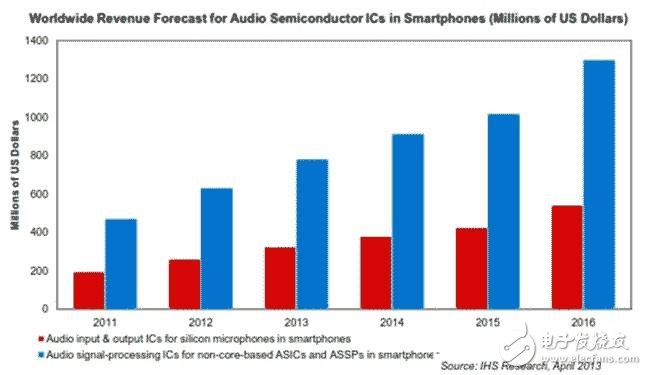According to the Audio IC report published by IMS Research, a subsidiary of IHS, the application of audio integrated circuits (ICs) in the field of mobile phones will increase dramatically due to the ability to improve sound quality and enhance the user interface for language recognition such as Apple Siri. It is expected to be used for noise reduction and Natural voice chips will be used the most.
The mobile phone is the largest single application field of the audio IC, mainly smart phones. In the two major audio IC application fields of smartphones-audio signal processing IC and silicon microphone audio input and output IC, at least in 2011-2016 will continue to grow at a double-digit rate. For example, the revenue of smart phone silicon microphone audio input and output ICs will increase from 193.9 million US dollars in 2011 to 322.8 million US dollars, and is expected to reach 540.5 million US dollars in 2016. This year's growth rate is 24%.

The operating income of audio signal processing ICs showed the same strong growth momentum. In the non-core-based IC field, including application-specific integrated circuits and application-specific standard products, this year's operating revenue is expected to grow from US $ 469.8 million in 2011 to US $ 779.6 million, and to US $ 1.3 billion in 2016. This year is expected to grow by 24%, the growth rate is the same as the audio input and output IC field. The five-year compound annual growth rate of these two types of audio ICs is much higher than 18%.
The growth of the audio IC market is greatly affected by the demand for media consumer devices. Media content is currently generally stored in systems such as the Internet cloud and then transmitted digitally. The ecosystem of audio content consumption is also constantly developing, focusing on the user experience so that it can obtain new content immediately.
Such easy access, in turn, is driving the growth of audio playback systems in portable devices such as mobile PCs, tablets and mobile phones. In 2011, the mobile phone accounted for 24% of the audio semiconductor operating income, close to 1 billion US dollars, and is expected to become the largest single application of audio IC.
Two growth trends: noise suppression and natural language
Since the consumption of personal entertainment content through portable devices has become the norm, audio semiconductor manufacturers have been working hard to provide users with a better audio experience. In particular, applications such as active noise suppression and speech recognition are entering new products, and the most successful applications have been integrated into silicon chips to liberate processors. Make it possible to handle additional functions, or reduce overall power consumption and cost by increasing processor efficiency.
In terms of noise suppression, manufacturers are using MEMS microphones to distinguish between the sounds of users and background sounds. For example, in very high-end smartphones, sometimes a complex processor-based multi-dimensional algorithm is used in the receiving device to eliminate environmental noise. This method can even be used in the receiving device to eliminate the ambient noise surrounding the transmitting device.
As for natural language, the technology has developed by leaps and bounds since limited voice control was used. Starting with smartphones such as Apple iPhones that use Siri, and Samsung Galaxy S, smartphone speech recognition can now recognize natural questions and commands and respond, instead of only responding to pre-programmed phrases.
IHS believes that natural language features are expected to be used in other smartphones in the next five years. In addition, the technology will definitely enhance new applications such as wearable electronic products, car driving assistance and voice-sensitive security in the near future.
Considering the innovative development of such applications, perhaps futuristic voice control scenarios like the badge communicator in Star Trek, the watch in Supreme Detective, and the Jarvis interface in Iron Man are not far away.
Traffic Lights are traffic lights that command traffic and are generally made up of red lights,green lights and yellow lights.The red light means no traffic,the green light is allowed to pass,and the yellow light is a warning.
Traffic lights are divided into:light motor vehicles, no-motor vehicles lights,pedestrian signal lights,direction indicator lamp(arrow lights),driveway lights,flashing warning lights,road and rail light plane crossing.
Traffic Lights
Traffic Lights,Traffic Lights For Sale,Traffic Lights Word Search,Traffic Lights Invented
Jiangsu chengxu Electric Group Co., Ltd , http://www.chengxulighting.com